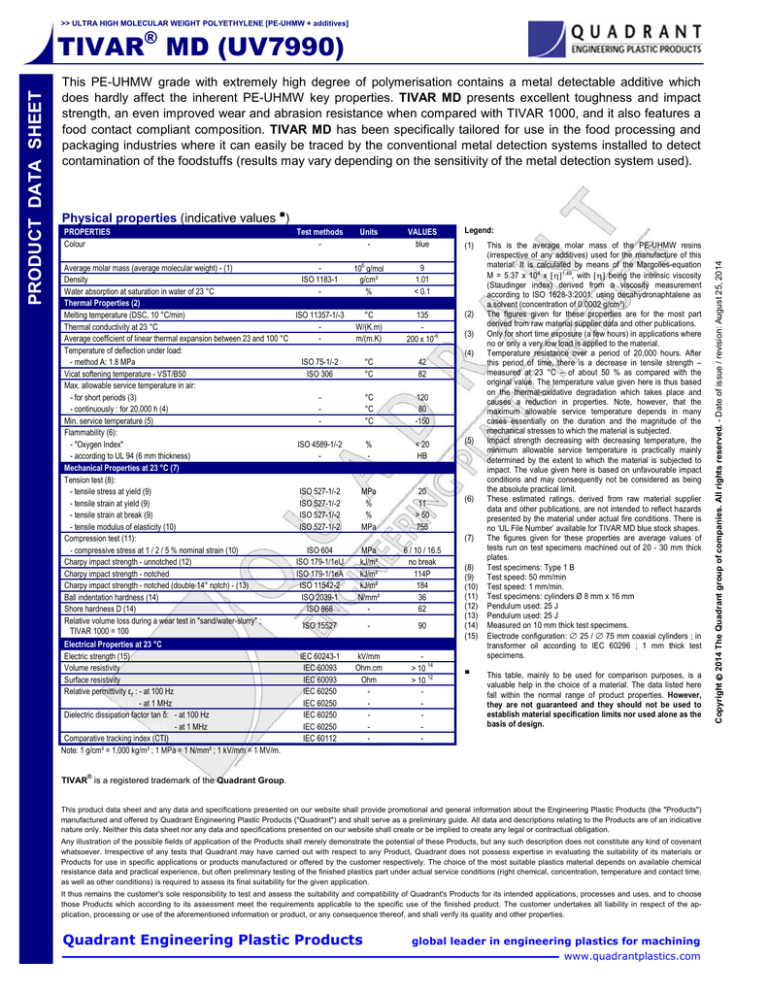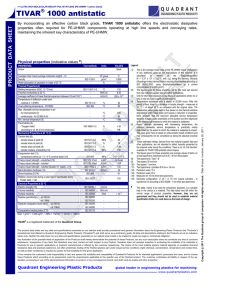
>> ULTRA HIGH MOLECULAR WEIGHT POLYETHYLENE [PE-UHMW + additives]
This PE-UHMW grade with extremely high degree of polymerisation contains a metal detectable additive which
does hardly affect the inherent PE-UHMW key properties. TIVAR MD presents excellent toughness and impact
strength, an even improved wear and abrasion resistance when compared with TIVAR 1000, and it also features a
food contact compliant composition. TIVAR MD has been specifically tailored for use in the food processing and
packaging industries where it can easily be traced by the conventional metal detection systems installed to detect
contamination of the foodstuffs (results may vary depending on the sensitivity of the metal detection system used).
Physical properties (indicative values g)
PROPERTIES
Colour
Test methods
-
Average molar mass (average molecular weight) - (1)
Density
ISO 1183-1
Water absorption at saturation in water of 23 °C
Thermal Properties (2)
Melting temperature (DSC, 10 °C/min)
ISO 11357-1/-3
Thermal conductivity at 23 °C
Average coefficient of linear thermal expansion between 23 and 100 °C
Temperature of deflection under load:
- method A: 1.8 MPa
ISO 75-1/-2
Vicat softening temperature - VST/B50
ISO 306
Max. allowable service temperature in air:
- for short periods (3)
- continuously : for 20,000 h (4)
Min. service temperature (5)
Flammability (6):
- "Oxygen Index"
ISO 4589-1/-2
- according to UL 94 (6 mm thickness)
Mechanical Properties at 23 °C (7)
Tension test (8):
- tensile stress at yield (9)
ISO 527-1/-2
- tensile strain at yield (9)
ISO 527-1/-2
- tensile strain at break (9)
ISO 527-1/-2
- tensile modulus of elasticity (10)
ISO 527-1/-2
Compression test (11):
- compressive stress at 1 / 2 / 5 % nominal strain (10)
ISO 604
Charpy impact strength - unnotched (12)
ISO 179-1/1eU
Charpy impact strength - notched
ISO 179-1/1eA
Charpy impact strength - notched (double 14° notch) - (13)
ISO 11542-2
Ball indentation hardness (14)
ISO 2039-1
Shore hardness D (14)
ISO 868
Relative volume loss during a wear test in "sand/water-slurry" ;
ISO 15527
TIVAR 1000 = 100
Electrical Properties at 23 °C
Electric strength (15)
IEC 60243-1
Volume resistivity
IEC 60093
Surface resistivity
IEC 60093
Relative permittivity εr : - at 100 Hz
IEC 60250
Relative permittivity εr : - at 1 MHz
IEC 60250
Dielectric dissipation factor tan δ: - at 100 Hz
IEC 60250
Dielectric dissipation factor tan δ: - at 1 MHz
IEC 60250
Comparative tracking index (CTI)
IEC 60112
Note: 1 g/cm³ = 1,000 kg/m³ ; 1 MPa = 1 N/mm² ; 1 kV/mm = 1 MV/m.
Units
-
VALUES
blue
106 g/mol
g/cm³
%
9
1.01
< 0.1
°C
W/(K.m)
m/(m.K)
135
-6
200 x 10
Legend:
(1)
(2)
(3)
(4)
°C
°C
42
82
°C
°C
°C
120
80
-150
%
-
< 20
HB
MPa
%
%
MPa
20
11
> 50
755
MPa
kJ/m²
kJ/m²
kJ/m²
N/mm²
-
6 / 10 / 16.5
no break
114P
184
36
62
-
90
kV/mm
Ohm.cm
Ohm
-
> 10 14
> 10 12
-
(5)
(6)
(7)
(8)
(9)
(10)
(11)
(12)
(13)
(14)
(15)
g
This is the average molar mass of the PE-UHMW resins
(irrespective of any additives) used for the manufacture of this
material. It is calculated by means of the Margolies-equation
M = 5.37 x 104 x [η]1.49, with [η] being the intrinsic viscosity
(Staudinger index) derived from a viscosity measurement
according to ISO 1628-3:2001, using decahydronaphtalene as
a solvent (concentration of 0.0002 g/cm³).
The figures given for these properties are for the most part
derived from raw material supplier data and other publications.
Only for short time exposure (a few hours) in applications where
no or only a very low load is applied to the material.
Temperature resistance over a period of 20,000 hours. After
this period of time, there is a decrease in tensile strength –
measured at 23 °C – of about 50 % as compared with the
original value. The temperature value given here is thus based
on the thermal-oxidative degradation which takes place and
causes a reduction in properties. Note, however, that the
maximum allowable service temperature depends in many
cases essentially on the duration and the magnitude of the
mechanical stresses to which the material is subjected.
Impact strength decreasing with decreasing temperature, the
minimum allowable service temperature is practically mainly
determined by the extent to which the material is subjected to
impact. The value given here is based on unfavourable impact
conditions and may consequently not be considered as being
the absolute practical limit.
These estimated ratings, derived from raw material supplier
data and other publications, are not intended to reflect hazards
presented by the material under actual fire conditions. There is
no ‘UL File Number’ available for TIVAR MD blue stock shapes.
The figures given for these properties are average values of
tests run on test specimens machined out of 20 - 30 mm thick
plates.
Test specimens: Type 1 B
Test speed: 50 mm/min
Test speed: 1 mm/min.
Test specimens: cylinders Ø 8 mm x 16 mm
Pendulum used: 25 J
Pendulum used: 25 J
Measured on 10 mm thick test specimens.
Electrode configuration: ∅ 25 / ∅ 75 mm coaxial cylinders ; in
transformer oil according to IEC 60296 ; 1 mm thick test
specimens.
This table, mainly to be used for comparison purposes, is a
valuable help in the choice of a material. The data listed here
fall within the normal range of product properties. However,
they are not guaranteed and they should not be used to
establish material specification limits nor used alone as the
basis of design.
®
TIVAR is a registered trademark of the Quadrant Group.
This product data sheet and any data and specifications presented on our website shall provide promotional and general information about the Engineering Plastic Products (the "Products")
manufactured and offered by Quadrant Engineering Plastic Products ("Quadrant") and shall serve as a preliminary guide. All data and descriptions relating to the Products are of an indicative
nature only. Neither this data sheet nor any data and specifications presented on our website shall create or be implied to create any legal or contractual obligation.
Any illustration of the possible fields of application of the Products shall merely demonstrate the potential of these Products, but any such description does not constitute any kind of covenant
whatsoever. Irrespective of any tests that Quadrant may have carried out with respect to any Product, Quadrant does not possess expertise in evaluating the suitability of its materials or
Products for use in specific applications or products manufactured or offered by the customer respectively. The choice of the most suitable plastics material depends on available chemical
resistance data and practical experience, but often preliminary testing of the finished plastics part under actual service conditions (right chemical, concentration, temperature and contact time,
as well as other conditions) is required to assess its final suitability for the given application.
It thus remains the customer's sole responsibility to test and assess the suitability and compatibility of Quadrant's Products for its intended applications, processes and uses, and to choose
those Products which according to its assessment meet the requirements applicable to the specific use of the finished product. The customer undertakes all liability in respect of the application, processing or use of the aforementioned information or product, or any consequence thereof, and shall verify its quality and other properties.
Quadrant Engineering Plastic Products
global leader in engineering plastics for machining
www.quadrantplastics.com
Copyright 2014 The Quadrant group of companies. All rights reserved. - Date of issue / revision: August 25, 2014
PRODUCT DATA SHEET T
TIVAR® MD (UV7990)







